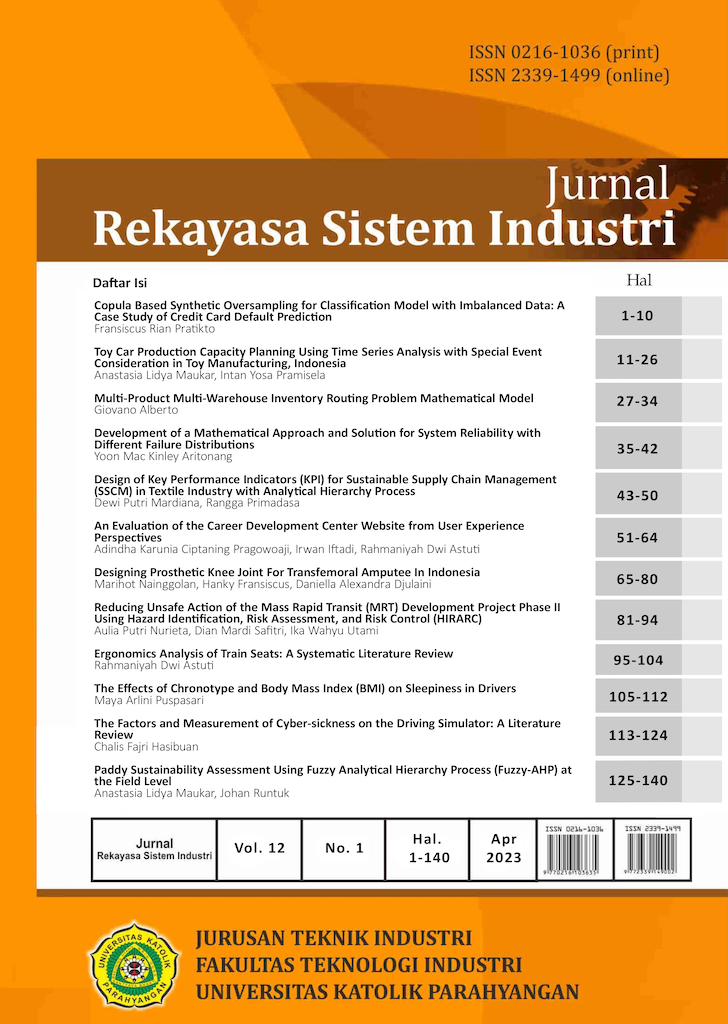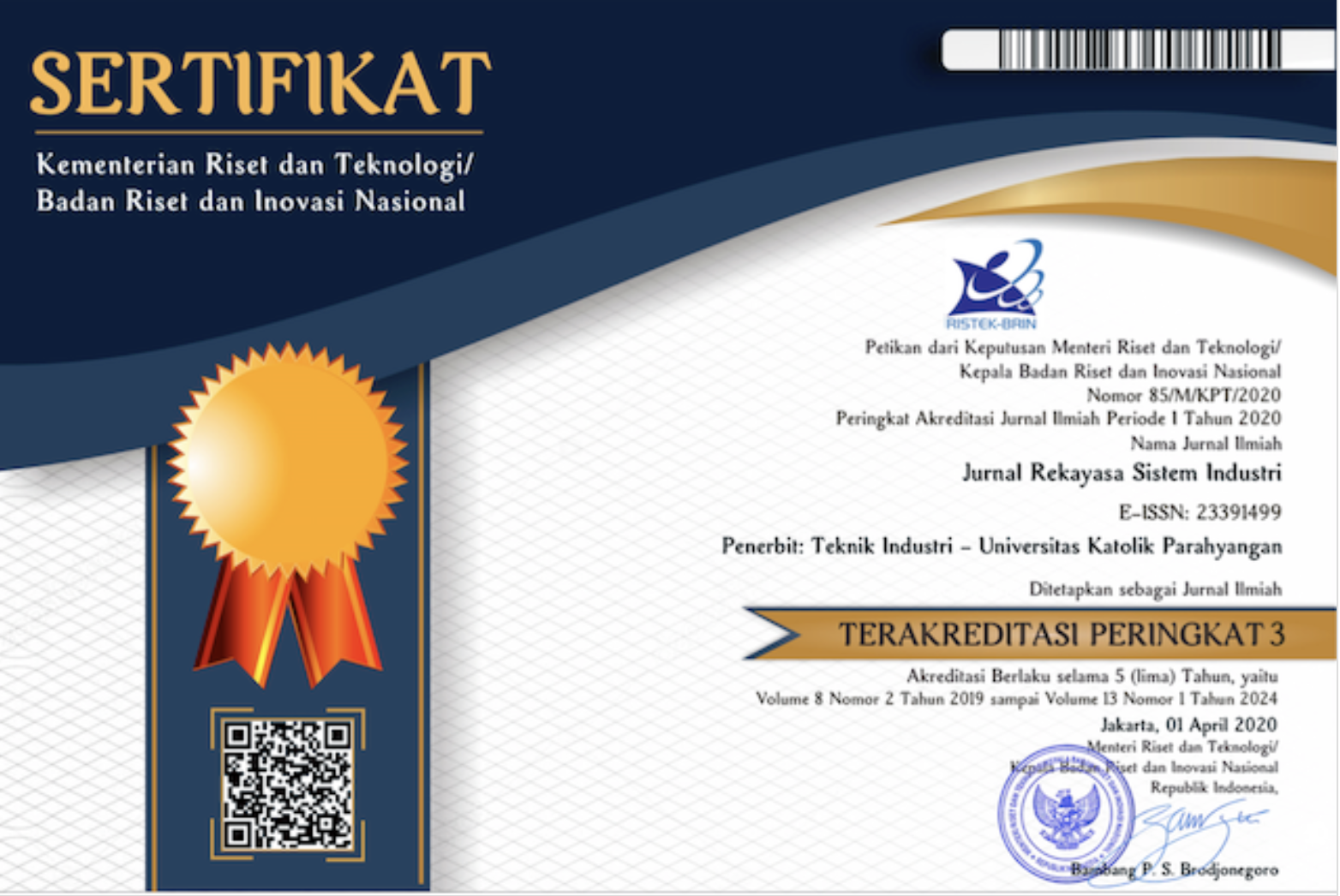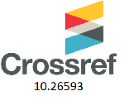Model Matematis untuk Multi-product Multi-warehouse Inventory Routing Problem
DOI:
https://doi.org/10.26593/jrsi.v12i1.6371.27-34Kata Kunci:
inventory, routing, multi-product, multi-warehouseAbstrak
Setiap perusahaan selalu berusaha dapat memperoleh keuntungan yang besar. Salah satu cara yang dapat dilakukan oleh perusahaan adalah menekan biaya yang dikeluarkan. Salah satu proses yang memerlukan biaya besar adalah logistik dan dua per tiga biaya logistik ini berasal dari biaya persediaan dan transportasi. Permasalahan persediaan dan transportasi pada perspektif supply chain perlu dipertimbangkan bersama agar dapat memberikan hasil yang optimal. Permasalahan ini dimodelkan dalam inventory routing problem (IRP). Pengembangan model IRP masih terdapat gap dengan kondisi nyata. Model IRP yang dirancang belum ada yang membahas terkait dengan model Multi-product Multi-warehouse Inventory Routing Problem (MMwIRP). MMIRP mempertimbangkan kondisi jenis barang yang perlu dikirimkan beragam dan terdapat beberapa gudang yang memiliki barang dengan jenis berbeda dalam satu periode waktu. Hasil yang didapatkan setelah menyelesaikan model adalah jumlah kendaraan yang digunakan, banyak barang dari setiap jenis yang dikirimkan, rute perjalanan yang dihasilkan oleh setiap kendaraan, dan besar biaya yang dihasilkan berdasarkan rancangan rute serta persediaan di setiap lokasi.
Referensi
Andersson, H., Hoff, A., Christiansen, M., Hasle, G. and Løkketangen, A. (2010), “Industrial aspects and literature survey: Combined inventory management and routing”, Computers and Operations Research, September, doi: 10.1016/j.cor.2009.11.009.
Archetti, C., Bertazzi, L., Hertz, A. and Grazia Speranza, M. (2012), “A hybrid heuristic for an inventory routing problem”, INFORMS Journal on Computing, Vol. 24 No. 1, pp. 101–116, doi: 10.1287/ijoc.1100.0439.
Bertazzi, L. and Speranza, M.G. (2012), “Inventory routing problems: an introduction”, EURO Journal on Transportation and Logistics, Elsevier BV, Vol. 1 No. 4, pp. 307–326, doi: 10.1007/s13676-012-0016-7.
Campbell, A.M. and Savelsbergh, M.W.P. (2004), “A decomposition approach for the inventory-routing problem”, Transportation Science, INFORMS Inst.for Operations Res.and the Management Sciences, Vol. 38 No. 4, pp. 488–502, doi: 10.1287/trsc.1030.0054.
Cao, J., Gao, J., Li, B. and Wang, X. (2020), The Inventory Routing Problem: A Review.
Coelho, L.C., Cordeau, J.F. and Laporte, G. (2014), “Thirty years of inventory routing”, Transportation Science, INFORMS Inst.for Operations Res.and the Management Sciences, Vol. 48 No. 1, pp. 1–19, doi: 10.1287/trsc.2013.0472.
Hewitt, M., Nemhauser, G., Savelsbergh, M. and Song, J.H. (2013), “A branch-and-price guided search approach to maritime inventory routing”, Computers and Operations Research, Vol. 40 No. 5, pp. 1410–1419, doi: 10.1016/j.cor.2012.09.010.
Lmariouh, J., Hachemi, N. el, Jamali, A. and Bouami, D. (2014), “The multi-vehicle mutli-product inventory-routing problem: A case study”, 2014 International Conference on Advanced Logistics and Transport, ICALT 2014, IEEE Computer Society, pp. 319–323, doi: 10.1109/ICAdLT.2014.6866332.
Moin, N.H. and Salhi, S. (2007), “Inventory routing problems: A logistical overview”, Journal of the Operational Research Society, Palgrave Macmillan Ltd., 26 September, doi: 10.1057/palgrave.jors.2602264.
Persson, J.A. and Göthe-Lundgren, M. (2005), “Shipment planning at oil refineries using column generation and valid inequalities”, European Journal of Operational Research, Vol. 163 No. 3, pp. 631–652, doi: 10.1016/j.ejor.2004.02.008.
Qu, W.W., Bookbinder, J.H. and Iyogun, P. (1999), An Integrated Inventory-Transportation System with Modified Periodic Policy for Multiple Products.
Ronen, D. (1993), Invited Review Ship Scheduling: The Last Decade, European Journal of Operational Research, Vol. 71.
Yeh, Y. and Low, C. (2017), “Mathematical Modelling for a Multi-Product Inventory Routing Problem with Split Delivery”, Journal of Applied Mathematics and Physics, Scientific Research Publishing, Inc, Vol. 05 No. 09, pp. 1607–1612, doi: 10.4236/jamp.2017.5913













